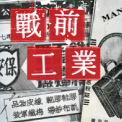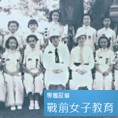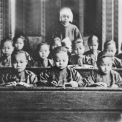1841-1865
OVERVIEW
The provision of education in Hong Kong was a combined effort of the colonial government, the Chinese community, and missionary bodies. When the British took possession of Hong Kong Island in 1841, there were already settled farming and fishing communities with temples and village schools on the south side of the Island. Initial government provision of education for the Chinese inhabitants was to distribute grants to existing schools. In 1847, Governor John Davis appointed a committee to survey Chinese schools in Victoria, Aberdeen and Stanley. A total number of 123 pupils from eight schools were recorded. Basic reading and writing, together with simple computation on the abacus was taught in these schools by Chinese school masters.
Upon the recommendation of the Committee, one school in each place was selected to be placed under the supervision of the government. A monthly grant in proportion to attendance would be given to the master. No tuition fees would be charged as they were defrayed by the government grants. The three school masters of respective schools were officially appointed as teachers of government schools. They were required to follow regulations regarding school management and discipline, such as keeping regular school hours and student records. The study of the Bible was added to the traditional Chinese curriculum of Yau Hok, Trimetrical Classic, and Thousand Character Book. Distribution of grants would be subjected to the inspection of the Committee for Superintendence of Chinese Education (or Education Committee). These ssu-shu style Chinese schools, each taught by a single Chinese school master, marked the establishment of ‘government schools’ for Chinese children in Hong Kong.
More schools were added to the list and teaching of elementary English was introduced to two of the schools in 1853. By 1859, there were 19 government-aided schools (including a girls’ school) educating 843 pupils according to the report of the first Inspector of Schools, the Revd William Lobscheid. As the economy took off, there was high demand for English education to produce bilingual assistants, clerks and interpreters for the commercial and public sectors. The restructured Board of Education led by the Revd James Legge submitted a scheme to consolidate the government schools and raise the standard of teaching and learning. The Central School was subsequently opened in premises on Gough Street in February 1862. It was to provide a non-religious Anglo-Chinese education for Chinese boys and young men under British masters. Mr Frederick Stewart was appointed the first Headmaster and the Inspector of Schools. Pupils admitted to the Central School would have completed an elementary Chinese education in village schools, and were assessed by a test upon admission.
Missionary Efforts
Roman Catholic and Protestant missionaries were the first groups to set up schools in ‘urban’ Hong Kong, which served the purposes of education, evangelism, and charity. Small-scale schools for boys and girls attached to chapels, churches and convents were recorded from early days. Nevertheless, education for boys and girls began at different starting points and developed along diverse courses over time.
Early boys’ mission schools aimed to provide a religious education for boys and young men, a number of them came from Macau and Mainland China, and train Christian teachers and assistants for the missionaries. Curriculum adopted in general included Chinese (or Portuguese), the study of the Bible, catechisms, English, history and geography. These early ventures struggled with unstable attendance, lack of funding and high turnover rate of missionaries due to ill health or relocation. Some of them closed down within a decade or so. Business and job opportunities offered by a newly established colony attracted Foreign and Chinese adventurers but not families, with the exception of Portuguese families relocated from Macau. Unrest, burglary, kidnapping and murder were not uncommon in early colonial Hong Kong. The colony was hardly a safe dwelling place for wealthy Chinese merchants and too costly for the coolies and labourers to bring their families here. Boys born in Hong Kong were often sent back to their home villages in China to be educated. The fast growing urban population largely constituted by transient adult male immigrant labour. Young men and teenage boys were drawn to the mission schools in the beginning but left for well-paid jobs soon after they acquired some English. In 1864, the West Point Reformatory teaching crafts such as shoemaking, book-binding, and carpentry was opened to serve the education need of another class of boys.
Girls’ schools were operated mostly in the line of foundling homes and orphanages. Abandoned infant girls, those who were rescued from trafficking and abuse, and those with disabilities were taken in by the missionaries and nuns. They were clothed and fed, taught needlework, basic reading and writing, and religious instructions. The aim was to educate them to be good wives and mothers. The girls would be married away to suitors screened by the missionaries when they grew up. Day schools and small scale boarding schools offering a vernacular education for Chinese girls and a European curriculum for Eurasian and European girls were also founded in late 1850s to early 1860s. Some of the graduates became teachers of mission schools while some joined the religious order. Overseas and local subscriptions helped to keep these education and charity works going from strength to strength.
1866-1913
OVERVIEW
The replacement of a voluntary Board of Education by the Department of Government Schools (later to be known as the Education Department) headed by the Inspector of Schools in 1865 marked a shift in policy-making for education in Hong Kong. The adoption of the Grant-in-aid scheme in 1873 further consolidated the role of voluntary efforts, particularly the Christian missions, in the provision of education for a fast expanding population. It also prescribed a loosely defined curriculum for different types of schools and introduced the measures of ‘payment by results’ to maintain standard and efficiency.
A new class of Chinese elites with considerable wealth and influence, represented by the Board of Directors of Tung Wah Hospital (1872) and Po Leung Kuk (1878), constituted the third party shaping the development of education in the colony. Starting from 1880, free schools (sometimes referred to as ‘kai fong’ schools in reports) were set up by Tung Wah Hospital to provide a free education following the traditional Chinese curriculum for poor Chinese children (mainly boys). These schools did not apply for government grants until the early 1910s to avoid foreign interference on its customs and practices. A group of prominent Chinese leaders also petitioned for the establishment of an Anglo-Chinese school in 1902 for children of the Chinese upper class. St Stephen’s College and St Stephen’s Girls’ College were subsequently opened. Chinese philanthropic efforts became a significant source of funding in education, from the grassroots level to the founding of the University of Hong Kong in 1911.
While the number of schools and student enrollment increased steadily under the Grant-in-aid scheme, the issue of attainment and modernisation emerged as focus of concern, as recorded in annual government and school reports, government correspondence, and the newspaper. In 1880, Governor John Pope Hennessy strongly criticized the unsatisfactory English standard of Central School’s students. An education commission was appointed to explore measures to enhance the teaching of English in government schools. To allocate more hours to English teaching, hours of instruction in Chinese were reduced and standard of Chinese attained upon admission was raised.
The Cambridge Local Examinations were introduced in 1886 and the Oxford Local Examinations in 1889. Being an examination centre of the Cambridge/Oxford Examinations put the pupils of Hong Kong on common ground of assessment with other colonies in the British Empire and the Metropole herself. Scholarships were set up by the Government and philanthropists such as Mr Belilios to select the best students from government district schools to the Central School, and from Central School to further study in England. Similar scholarships were also offered to pupils of individual Grant-in-aid schools. The Central School for Girls (later renamed Belilios Public School) was founded in 1890 to give an Anglo-Chinese education for girls. It was believed that English language and culture could not be promoted by educating the young men only. It was the educated wives and mothers that would take up the civilizing role.
In the late nineteenth to early twentieth century, political movements and education reform in China greatly challenged the education system and policy of colonial Hong Kong. An Education Committee was appointed in 1901 to conduct a full review on education attainment, need and provision. The effectiveness of vernacular schools (Class I schools in the Grant-in-aid system) running along the line of traditional Chinese ssu-shu was strongly criticized in the committee report. However, the report observed that girls’ schools in this group were better managed and the girls out-performed their counterparts in boys’ schools. The Committee suggested that modern textbooks and method of teaching were to be adopted in vernacular schools. A new Grant Code which made grants dependent on inspection of schools instead of an annual examination of pupils was implemented in 1903. A Technical Institute was established in 1907 to run evening continuation classes in various technical subjects and also ‘normal classes’ (teachers’ training) for teachers.
Social and political changes in China brought influx of refugees into Hong Kong. The 1911 Census reported a 60% increase of Chinese population in a decade, rising from 274,543 in 1901 to 438,873. Great numbers of private schools were opened in tenement houses to cater for the need of unschooled children. Credibility, agenda and efficiency of these schools varied a great deal. A semi-official Board of Vernacular Primary Education was formed in 1911 to explore ways and funding to meet the pressing need to expand provision for vernacular education. In 1913, the first Education Ordinance was passed to provide for the registration and supervision of certain schools. Registration was required for all schools with ten or more pupils, apart from those exemptions had been granted. Hygiene, ways of enforcing discipline, choice of texbooks, proper conduct and efficiency were the criteria affecting the approval of registration by the Director of Education.
The University of Hong Kong was founded in 1911 and officially opened in 1912. The institution not only aimed to ‘afford the highest educational facilities to the citizens of Hong Kong’, but to ‘assist China to educate her sons’, claimed the Governor, Sir Frederick Lugard, at the Foundation Stone Laying Ceremony. The University was opened with a Faculty of Medicine. The faculties of Engineering and Arts were added within a year. The opening of the University directly affected the curriculum of secondary schools. The Grant Code was later revised to encourage upper classes of Anglo-Chinese Grant schools to take the Matriculation and Local Examinations of the University.
1914-1941
OVERVIEW
The landscape of education in Hong Kong was dramatically changed from late 1910s to the Japanese Occupation in 1941. The 1921 and 1931 Census Returns reported a continual population growth of 36% and 34% respectively. Among the new immigrants from China were scholars and teachers who wanted to promote a modernized education integrating western knowledge and national education in colonial Hong Kong. A number of Chinese schools for boys and girls funded by private subscription, and taught by graduates of Chinese teachers’ colleges and universities were founded in this period. They adopted the curriculum of China and registered with the Ministry of Education of the Republican government. Upon completion of their study in these schools, students would be examined by Chinese officials in Hong Kong or attended examination in Canton. The few who aspired for higher education could apply for universities in China. They were regarded as ‘Overseas Chinese School’ from the perspective of the Chinese government while operating as registered private schools under the Education Department in Hong Kong. Size and standard of these schools varied and not all were registered in China.
The great number of refugee children flooding into Hong Kong in late 1930s also prompted charitable organisations, trade unions and individuals to set up free schools to provide basic education and care. There was also an increase of private English day and evening schools providing basic commercial training for adults looking for jobs in the colony. Private schools as a generic group became the largest group of schools providing education in Hong Kong. The 1939 Education Report estimated that there were 972 private education institutions of all categories, educating 54,744 males and 23,699 females in the year reported. Whereas there were only 4,664 males, and 1,257 females being educated in 12 government schools and 20,961 males, 12, 250 females in 295 aided schools. .
The increasing need to raise the standard of English to meet the demand of university education and professional training, and rising patriotic sentiments were two driving forces shaping education in this period. Government and Grant-in-aid schools continued to put emphasis on English education but the teaching of Chinese was not to be neglected. Chinese was made a compulsory subject for all Chinese boys and girls in Anglo-Chinese schools. The Government Vernacular Middle School was opened in 1926 after the General Strike and Boycott in 1925. Chinese Christians also founded a new type of Christian schools emphasizing both national and religious education.
After the outbreak of the Sino-Japanese War on the Mainland, more Chinese mission schools relocated to Hong Kong from the Kwantung Province. The Young Men’s Christian Association (YMCA) and Young Women’s Christian Association (YWCA) also organized activities and training to enhance student’s commitment to the Christian religion and their national identity. Women’s education opportunity improved when the University of Hong Kong finally admitted women as students in 1921.
Schooling experience in Government and Aided schools became more diversified. Physical education was made a required subject. Inter-school football and basketball matches, scouting, competition on drama, speech, and music were now part of everyday school life. In the larger schools, the ideal of giving service to the needy was taught and practiced through the organisation of free schools for poor children, fund-raising bazaars and concerts, and visits to hospital and orphanages. At the same time, a scheme of technical education was submitted to provide an alternative for students and meet the demand of various professions.
Edmund Burney, one of His Majesty Inspectors of Schools in England, visited Hong Kong in 1935 to give a full review on Hong Kong education. In his report it was recommended that the government should assume larger responsibilities in primary education. The teaching of English should be on a utilitarian basis and a teachers’ training college would be necessary. His suggestions were largely accepted. A new Subsidy Code was established to promote vernacular education at the primary level. A committee was appointed to review current teachers’ training provided by the University of Hong Kong and the Evening Institute. Subsequently a new Training College (renamed Northcote Training College in 1940) was opened in 1939. Unfortunately the outbreak of war in 1941 much delayed the implementation of plans and reforms.





